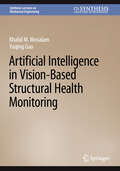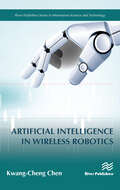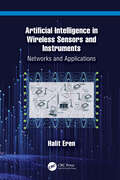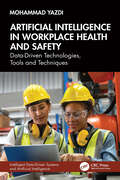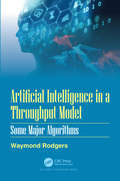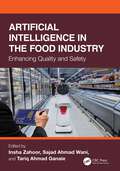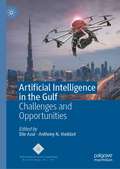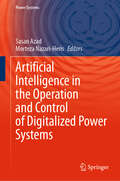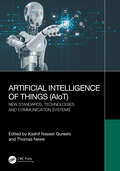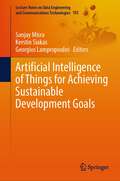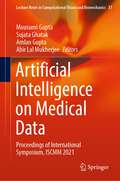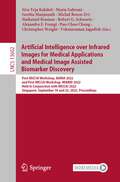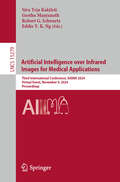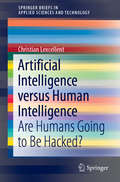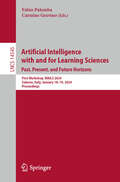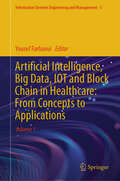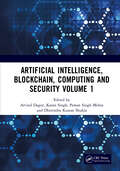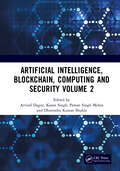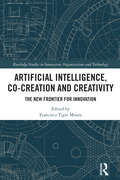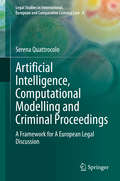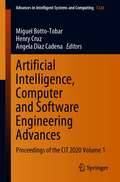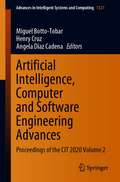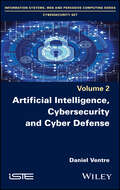- Table View
- List View
Artificial Intelligence in Vision-Based Structural Health Monitoring (Synthesis Lectures on Mechanical Engineering)
by Khalid M. Mosalam Yuqing GaoThis book provides a comprehensive coverage of the state-of-the-art artificial intelligence (AI) technologies in vision-based structural health monitoring (SHM). In this data explosion epoch, AI-aided SHM and rapid damage assessment after natural hazards have become of great interest in civil and structural engineering, where using machine and deep learning in vision-based SHM brings new research direction. As researchers begin to apply these concepts to the structural engineering domain, especially in SHM, several critical scientific questions need to be addressed: (1) What can AI solve for the SHM problems? (2) What are the relevant AI technologies? (3) What is the effectiveness of the AI approaches in vision-based SHM? (4) How to improve the adaptability of the AI approaches for practical projects? (5) How to build a resilient AI-aided disaster prevention system making use of the vision-based SHM? This book introduces and implements the state-of-the-art machine learning and deep learning technologies for vision-based SHM applications. Specifically, corresponding to the above-mentioned scientific questions, it consists of: (1) motivation, background & progress of AI-aided vision-based SHM, (2) fundamentals of machine learning & deep learning approaches, (3) basic AI applications in vision-based SHM, (4) advanced topics & approaches, and (5) resilient AI-aided applications. In the introduction, a brief coverage about the development progress of AI technologies in the vision-based area is presented. It gives the readers the motivations and background of the relevant research. In Part I, basic knowledges of machine and deep learning are introduced, which provide the foundation for the readers irrespective of their background. In Part II, to verify the effectiveness of the AI methods, the key procedure of the typical AI-aided SHM applications (classification, localization, and segmentation) is explored, including vision data collection, data pre-processing,transfer learning-based training mechanism, evaluation, and analysis. In Part III, advanced AI topics, e.g., generative adversarial network, semi-supervised learning, and active learning, are discussed. They aim to address several critical issues in practical projects, e.g., the lack of well-labeled data and imbalanced labels, to improve the adaptability of the AI models. In Part IV, the new concept of “resilient AI” is introduced to establish an intelligent disaster prevention system, multi-modality learning, multi-task learning, and interpretable AI technologies. These advances are aimed towards increasing the robustness and explainability of the AI-enabled SHM system, and ultimately leading to improved resiliency.The scope covered in this book is not only beneficial for education purposes but also is essential for modern industrial applications. The target audience is broad and includes students, engineers, and researchers in civil engineering, statistics, and computer science. Unique Book Features:• Provide a comprehensive review of the rapidly expanding field of vision-based structural health monitoring (SHM) using artificial intelligence approaches. • Re-organize fundamental knowledge specific to the machine and deep learning in vision tasks.• Include comprehensive details about the procedure of conducting AI approaches for vision-based SHM along with examples and exercises.• Cover a vast array of special topics and advanced AI-enabled vision-based SHM applications.• List a few potential extensions for inspiring the readers for future investigation.
Artificial Intelligence in Wireless Robotics (River Publishers Series In Information Science And Technology Ser.)
by Kwang-Cheng ChenRobots, autonomous vehicles, unmanned aerial vehicles, and smart factory, will significantly change human living style in digital society. Artificial Intelligence in Wireless Robotics introduces how wireless communications and networking technology enhances facilitation of artificial intelligence in robotics, which bridges basic multi-disciplinary knowledge among artificial intelligence, wireless communications, computing, and control in robotics. A unique aspect of the book is to introduce applying communication and signal processing techniques to enhance traditional artificial intelligence in robotics and multi-agent systems.The technical contents of this book include fundamental knowledge in robotics, cyber-physical systems, artificial intelligence, statistical decision and Markov decision process, reinforcement learning, state estimation, localization, computer vision and multi-modal data fusion, robot planning, multi-agent systems, networked multi-agent systems, security and robustness of networked robots, and ultra-reliable and low-latency machine-to-machine networking. Examples and exercises are provided for easy and effective comprehension.Engineers wishing to extend knowledge in the robotics, AI, and wireless communications, would be benefited from this book. In the meantime, the book is ready as a textbook for senior undergraduate students or first-year graduate students in electrical engineering, computer engineering, computer science, and general engineering students. The readers of this book shall have basic knowledge in undergraduate probability and linear algebra, and basic programming capability, in order to enjoy deep reading.
Artificial Intelligence in Wireless Sensors and Instruments: Networks and Applications
by Halit ErenThis book heralds a new era in instrumentation and measurements. It combines artificial intelligence (AI) and wireless communications technologies with instrumentation and measurement systems to function as a single unit. AI has advanced considerably due to deep learning utilizing artificial neural networks, availability of large and curated datasets, implementation of a new generation of fast processors having millions of transistors in chips, advanced algorithms, competitive commercial interests, and interests of governments to gain advantages. At the same time, new and highly advanced wireless technologies open new frontiers in communication systems, both technologically and in terms of applications aspects. Advanced technologies such as 5G and 6G networks enable easy use of communication systems by billions of people as well as by billions of machine-to-machine systems.In this book, the communication principles are explained and the implementation of AI on wireless networks is discussed. Many examples are provided. The author discusses instruments and instrumentation networks, modern sensors, and transducers in detail.AI is the technology humans have created where the machines do not only assist us but also think for us creatively in some cases, excelling humans thinking and reasoning. This book includes a chapter explaining how this is done, backed up with more than 50 figures. The security issues, fairness, efficiency, and social impact and acceptance of AI are highlighted. As explained in this book, AI and wireless communications are changing our lives in many ways, including entertainment, games, social interactions, medicine and healthcare, R&D, automated living, intelligent transport systems, finance and economy, and the Internet of Things.
Artificial Intelligence in Workplace Health and Safety: Data-Driven Technologies, Tools and Techniques (Intelligent Data-Driven Systems and Artificial Intelligence)
by Mohammad YazdiIn today's dynamic workplace environment, ensuring the safety and well-being of employees has never been more critical. This book explores cutting-edge technologies intersecting with workplace safety to deliver effective and practical results.Artificial Intelligence in Workplace Health and Safety: Data-Driven Technologies, Tools and Techniques offers a comprehensive roadmap for professionals, researchers, and practitioners in work health and safety (WHS), revolutionizing traditional approaches through the integration of data-driven methodologies and artificial intelligence. Covering the foundations and practical applications of data-driven WHS and historical perspectives to current regulatory frameworks, it investigates the key concepts of data collection, management, and integration. Through real-world case studies and examples, readers can discover how AI technologies such as machine learning, computer vision, and natural language processing are reshaping WHS practices, mitigating risks, and optimizing safety measures. The reader will learn applications of AI and data-driven methodologies in their workplace settings to improve safety. With its practical insights, real-world examples, and progressive approach, this title ensures that readers are not just prepared for the future of WHS but empowered to shape it for better. This text is written for professionals and practitioners seeking to enhance workplace safety through innovative technologies. This extends to safety professionals, HR personnel and engineers across different sectors.
Artificial Intelligence in a Throughput Model: Some Major Algorithms
by Waymond RodgersPhysical and behavioral biometric technologies such as fingerprinting, facial recognition, voice identification, etc. have enhanced the level of security substantially in recent years. Governments and corporates have employed these technologies to achieve better customer satisfaction. However, biometrics faces major challenges in reducing criminal, terrorist activities and electronic frauds, especially in choosing appropriate decision-making algorithms. To face this challenge, new developments have been made, that amalgamate biometrics with artificial intelligence (AI) in decision-making modeling. Advanced software algorithms of AI, processing information offered by biometric technology, achieve better results. This has led to growth in the biometrics technology industry, and is set to increase the security and internal control operations manifold. This book provides an overview of the existing biometric technologies, decision-making algorithms and the growth opportunity in biometrics. The book proposes a throughput model, which draws on computer science, economics and psychology to model perceptual, informational sources, judgmental processes and decision choice algorithms. It reviews how biometrics might be applied to reduce risks to individuals and organizations, especially when dealing with digital-based media.
Artificial Intelligence in the Food Industry: Enhancing Quality and Safety
by Tariq Ahmad Ganaie Sajad Ahmad Wani Insha ZahoorIn this changing world of food processing and handling, efficiency and safety are paramount. Artificial Intelligence in the Food Industry: Enhancing Quality and Safety offers a groundbreaking exploration of how artificial intelligence (AI) technologies can address these critical needs. This book explores the transformative potential of AI, machine learning (ML), and deep learning (DL) algorithms in revolutionizing the food industry. By overcoming the limitations of human involvement, AI ensures a more reliable demand-supply chain and enhances food safety.As the global population grows and food consumption reaches unprecedented levels, the demand for innovative solutions is urgent. This book demonstrates how intelligent systems can accurately assess food quality, implement control mechanisms, categorize foods, and conduct predictive analyses. Such advancements are reshaping sectors, including dairy, bakery, beverages, and fruits and vegetables, making this an indispensable guide for food production and safety professionals.It explores several cutting-edge topics such as the role of ML and computer vision in the agri-food industry, the potential of 3D printing, and the integration of AI with sensory technologies like electronic noses, electronic tongues, and near-infrared spectroscopy. These insights highlight how AI can significantly enhance food quality and productivity, benefiting both consumers and industry players.Artificial Intelligence in the Food Industry not only showcases current advancements but also emphasizes the need for ongoing research and innovation. By inviting readers to explore AI’s transformative potential in food production and service, this book ensures a safer, more efficient, and sustainable future for the food industry.A vital resource for researchers, scientists, and professionals in the food industry, this book presents comprehensive information on ML techniques to improve food quality, AI applications in pesticide management, food inspection, grading using image processing, and the use of robots for food safety and warehouse management.
Artificial Intelligence in the Gulf
by Elie Azar Anthony N. HaddadThis book presents the first broad reflection on the challenges, opportunities, and implications of Artificial Intelligence (AI) in the Gulf Cooperation Council (GCC). Unique results and insights are derived through case studies from diverse disciplines, including engineering, economics, data science, policy-making, governance, and humanscience. Particularly related to these ‘softer’ disciplines, we make some unexplored yet topical contributions to the literature, with a focus on the GCC (but by no means limited to it), including AI and implications for women, Islamic schools of thought on AI, and the power of AI to help deliver wellbeing and happiness in cities and urban spaces. Finally, the readers are provided with a synthesis of ideas, lessons learned, and a path forward based on the diverse content of the chapters. The book caters to the educated non specialist with interest in AI, targeting a wide audience including professionals, academics, government officials, policymakers, entrepreneurs, and non-governmental organizations.
Artificial Intelligence in the Operation and Control of Digitalized Power Systems (Power Systems)
by Morteza Nazari-Heris Sasan AzadThis book covers the practical application of AI-based methods in modern power systems. The complexity of current power system operations has dramatically increased due to the higher penetration of renewable energy sources and power electronic components. Therefore, providing efficient techniques is essential for secure and clean power system operation. This book focuses on the data-driven operation of the digitalized power system using machine language (ML). First, the basics of power system operation and control are presented, covering various areas of system control and operation. Next, significant advances in modern power systems and their corresponding challenges are discussed, and artificial intelligence (AI)-powered techniques, specifically machine learning, are introduced to address these issues. The book also explores AI-powered applications in the operation of power systems. These applications include various aspects of the data-driven process in both situational awareness and control areas. They are presented as practical examples indicating the implementation of an ML-based method to solve operational problems. Artificial Intelligence in the Operation and Control of Digitalized Power Systems is a valuable guide for students, researchers, and practicing engineers to AI-based techniques and real-world applications in power systems.
Artificial Intelligence of Things (AIoT): New Standards, Technologies and Communication Systems
by Kashif Naseer Qureshi Thomas NeweThis book is devoted to the new standards, technologies, and communication systems for Artificial Intelligence of Things (AIoT) networks. Smart and intelligent communication networks have gained significant attention due to the combination of AI and IoT networks to improve human and machine interfaces and enhance data processing and services. AIoT networks involve the collection of data from several devices and sensor nodes in the environment. AI can enhance these networks to make them faster, greener, smarter, and safer. Computer vision, language processing, and speech recognition are some examples of AIoT networks.Due to a large number of devices in today’s world, efficient and intelligent data processing is essential for problem-solving and decision-making. AI multiplies the value of these networks and promotes intelligence and learning capabilities, especially in homes, offices, and cities. However, several challenges have been observed in deploying AIoT networks, such as scalability, complexity, accuracy, and robustness. In addition, these networks are integrated with cloud, 5G networks, and blockchain methods for service provision. Many different solutions have been proposed to address issues related to machine and deep learning methods, ontology-based approaches, genetic algorithms, and fuzzy-based systems.This book aims to contribute to the state of the art and present current standards, technologies, and approaches for AIoT networks. This book focuses on existing solutions in AIoT network technologies, applications, services, standards, architectures, and security provisions. This book also introduces some new architectures and models for AIoT networks.
Artificial Intelligence of Things for Achieving Sustainable Development Goals (Lecture Notes on Data Engineering and Communications Technologies #192)
by Sanjay Misra Kerstin Siakas Georgios LampropoulosThis book covers various topics and trends regarding Artificial Intelligence (AI), Internet of Things (IoT), and their applications in society, industry, and environment for achieving Sustainable Development Goals (SDGs) suggested by the United Nations. Additionally, it discusses their advancements and fusion as well as the realization of Artificial Intelligence of Things (AIoT). The book aims to provide an overview and recent research into the fusion, integration, advancements, and impact of these technologies in the context of SDGs achievement. The topics include the applications of AI, IoT, big data, AI-based and IoT-based cloud computing, machine learning and deep learning techniques, and blockchain among others for achieving SDGs. It also presents findings and discussions on potential application domains, addresses open issues and challenges, offers solutions, and provides suggestions for future research for achieving SDGs. The chapters are clustered, according to particular SDGsor areas of focus, into: i) the realization of AIoT for SDGs, ii) the role of AIoT in achieving society and wellbeing-related SDGs, iii) the fulfillment of industrial sectors, infrastructure, and economy-related SDGs through AIoT, and iv) the use of AIoT to aid natural resources and environment-related SDGs. The book assists researchers, practitioners, professionals, and academicians of various scientific fields in exploring and better understanding these state-of-the-art technologies, their advancements, impact, future potentials and benefits, and their role in successfully achieving SDGs.The book:· Offers an in-depth overview of AIoT for achieving SDGs.· Presents the fusion of AI and IoT for bringing a significant change in everyday life and fulfilling SDGs.· Highlights innovative solutions and results of AIoT integration in several domains for achieving SDGs.· Showcases the influence of AIoT on promoting and improving sustainability in the context of SDGs.· Discusses the issues, benefits, solutions, and impact of AIoT in society, industry, and environment for achieving SDGs.
Artificial Intelligence of Things for Smart Green Energy Management (Studies in Systems, Decision and Control #446)
by Mariya Ouaissa Zakaria Boulouard Mariyam Ouaissa Sarah El Himer Abdulrahman A. A. EmhemedThis book is intended to assist in the development of smart and efficient green energy solutions. It introduces energy systems, power generation, and power demands which able to minimise generation costs, power loss or environmental effects. It proposes cutting-edge solutions and approaches based on recent technologies such as intelligent renewable energy systems (wind and solar). These solutions, applied to different sectors, can provide a solid basis for meeting the needs of both developed and developing countries. The book provides a collection of contributions including new techniques, methods, algorithms, practical solutions and models based on applying artificial intelligence and the Internet of things into green energy management systems. It provides a comprehensive reference for researchers, scholars and industry in the field of green energy and computational intelligence.
Artificial Intelligence on Medical Data: Proceedings of International Symposium, ISCMM 2021 (Lecture Notes in Computational Vision and Biomechanics #37)
by Mousumi Gupta Sujata Ghatak Amlan Gupta Abir Lal MukherjeeThis book includes high-quality papers presented at the Second International Symposium on Computer Vision and Machine Intelligence in Medical Image Analysis (ISCMM 2021), organized by Computer Applications Department, SMIT in collaboration with Department of Pathology, SMIMS, Sikkim, India, and funded by Indian Council of Medical Research, during 11 – 12 November 2021. It discusses common research problems and challenges in medical image analysis, such as deep learning methods. It also discusses how these theories can be applied to a broad range of application areas, including lung and chest x-ray, breast CAD, microscopy and pathology. The studies included mainly focus on the detection of events from biomedical signals.
Artificial Intelligence over Infrared Images for Medical Applications and Medical Image Assisted Biomarker Discovery: First MICCAI Workshop, AIIIMA 2022, and First MICCAI Workshop, MIABID 2022, Held in Conjunction with MICCAI 2022, Singapore, September 18 and 22, 2022, Proceedings (Lecture Notes in Computer Science #13602)
by Alejandro F. Frangi Robert G. Schwartz Geetha Manjunath Michal Rosen-Zvi Maria Gabrani Christopher Weight Siva Teja Kakileti Nathaniel Braman Pau-Choo Chung Vekataraman JagadishThis book constitutes the refereed proceedings of the First Workshop on Artificial Intelligence over Infrared Images for Medical Applications, AIIIMA 2022, and the First Workshop on Medical Image Assisted Biomarker Discovery, MIABID 2022, both held in conjunction with MICCAI 2022, Singapore, during September 18 and 22, 2022.For MIABID 2022, 7 papers from 10 submissions were accepted for publication. This workshop created a forum to discuss this specific sub-topic at MICCAI and promote this novel area of research among the research community that has the potential to hugely impact our society.For AIIIMA 2022, 10 papers from 15 submissions were accepted for publication. The first workshop on AIIIMA aimed to create a forum to discuss this specific sub-topic of AI over Infrared Images for Medical Applications at MICCAI and promote this novel area of research that has the potential to hugely impact our society, among the research community.
Artificial Intelligence over Infrared Images for Medical Applications: Third International Conference, AIIIMA 2024, Virtual Event, November 9, 2024, Proceedings (Lecture Notes in Computer Science #15279)
by Eddie Y. K. Ng Robert G. Schwartz Geetha Manjunath Siva Teja KakiletiThis book constitutes the refereed proceedings of the Third International Conference on Artificial Intelligence over Infrared Images for Medical Applications, AIIIMA 2024, held as a virtual event, on November 9, 2024. The 11 full papers presented in these proceedings were carefully reviewed and selected from 27 submissions. These papers focus on the application of Artificial Intelligence in medical infrared imaging for cancer screening, cancer diagnosis, cancer risk assessment, treatment monitoring, sports injury, diabetic foot ulcers detection, and pain management.
Artificial Intelligence versus Human Intelligence: Are Humans Going to Be Hacked? (SpringerBriefs in Applied Sciences and Technology)
by Christian LexcellentThis book showcases the fascinating but problematic relationship between human intelligence and artificial intelligence: AI is often discussed in the media, as if bodiless intelligence could exist, without a consciousness, without an unconscious, without thoughts. Using a wealth of anecdotes, data from academic literature, and original research, this short book examines in what circumstances robots can replace humans, and demonstrates that by operating beyond direct human control, strong artificial intelligence may pose serious problems, paving the way for all manner of extrapolations, for example implanting silicon chips in the brains of a privileged caste, and exposing the significant gap still present between the proponents of "singularity" and certain philosophers. With insights from mathematics, cognitive neuroscience and philosophy, it enables readers to understand and continue this open debate on AI, which presents concrete ethical problems for which meaningful answers are still in their infancy.
Artificial Intelligence with and for Learning Sciences. Past, Present, and Future Horizons: First Workshop, WAILS 2024, Salerno, Italy, January 18-19, 2024, Proceedings (Lecture Notes in Computer Science #14545)
by Fabio Palomba Carmine GravinoThis book constitutes the refereed conference proceedings of the First Workshop on Artificial Intelligence with and for Learning Sciences - Past, Present, and Future Horizons, WAILS 2024, held in Salerno, Italy, during January 18-19, 2024. The 14 full papers and 5 short papers presented in this book were carefully reviewed. The contributions present and discuss previous achievements, current challenges and solutions, and future perspectives concerned with the adoption of artificial intelligence methods and techniques in the context of learning sciences.
Artificial Intelligence, Big Data, IOT and Block Chain in Healthcare: Volume 1 (Information Systems Engineering and Management #5)
by Yousef FarhaouiThis book covers a wide range of topics related to the integration of Artificial Intelligence, Big Data, IoT, and Blockchain: From Concepts to Applications. It begins by establishing a solid foundation and introducing the concepts and principles of each technology. The subsequent chapters delve into the various applications and use cases, providing readers with real-world examples of how AI, IoT, and Blockchain can be leveraged to address key challenges in Smart Environments. Data is becoming an increasingly decisive resource in modern societies, economies, and governmental organizations. Data science, Artificial Intelligence, and Smart Environments inspire novel techniques and theories drawn from mathematics, statistics, information theory, computer science, and social science. This book reviews the state of the art of big data analysis, Artificial Intelligence, and Smart Environments. It includes issues that pertain to signal processing, probability models, machine learning, data mining, databases, data engineering, pattern recognition, visualization, predictive analytics, data warehousing, data compression, computer programming, smart city, etc. The papers in this book were the outcome of research conducted in this field of study. The latter makes use of applications and techniques related to data analysis in general and big data and smart cities in particular. The authors hope that this book serves as a valuable resource and guide for readers, empowering them to navigate the intricate landscape of Artificial Intelligence, IoT, and Blockchain in Smart Environments. Let the authors embark on this transformative journey together, as the authors explore the concepts and applications that hold the potential to shape the future of Smart Environments. The book appeals to advanced undergraduate and graduate students, post-doctoral researchers, lecturers, and industrial researchers, as well as anyone interested in big data analysis and Artificial Intelligence.
Artificial Intelligence, Big Data, IOT and Block Chain in Healthcare: Volume 2 (Information Systems Engineering and Management #6)
by Yousef FarhaouiThis book covers a wide range of topics related to the integration of Artificial Intelligence, Big Data, IoT, and Blockchain: From Concepts to Applications. It begins by establishing a solid foundation and introducing the concepts and principles of each technology. The subsequent chapters delve into the various applications and use cases, providing readers with real-world examples of how AI, IoT, and Blockchain can be leveraged to address key challenges in Smart Environments. Data is becoming an increasingly decisive resource in modern societies, economies, and governmental organizations. Data science, Artificial Intelligence, and Smart Environments inspire novel techniques and theories drawn from mathematics, statistics, information theory, computer science, and social science. This book reviews the state of the art of big data analysis, Artificial Intelligence, and Smart Environments. It includes issues that pertain to signal processing, probability models, machine learning, data mining, databases, data engineering, pattern recognition, visualization, predictive analytics, data warehousing, data compression, computer programming, smart city, etc. The papers in this book were the outcome of research conducted in this field of study. The latter makes use of applications and techniques related to data analysis in general and big data and smart cities in particular. The authors hope that this book serves as a valuable resource and guide for readers, empowering them to navigate the intricate landscape of Artificial Intelligence, IoT, and Blockchain in Smart Environments. Let the authors embark on this transformative journey together, as the authors explore the concepts and applications that hold the potential to shape the future of Smart Environments. The book appeals to advanced undergraduate and graduate students, post-doctoral researchers, lecturers, and industrial researchers, as well as anyone interested in big data analysis and Artificial Intelligence.
Artificial Intelligence, Blockchain, Computing and Security Volume 1: Proceedings of the International Conference on Artificial Intelligence, Blockchain, Computing and Security (ICABCS 2023), Gr. Noida, UP, India, 24 - 25 February 2023
by Karan Singh Pawan Singh Mehra Arvind Dagur Dhirendra Kumar ShuklaThis book contains the conference proceedings of ICABCS 2023, a non-profit conference with the objective to provide a platform that allows academicians, researchers, scholars and students from various institutions, universities and industries in India and abroad to exchange their research and innovative ideas in the field of Artificial Intelligence, Blockchain, Computing and Security. It explores the recent advancement in field of Artificial Intelligence, Blockchain, Communication and Security in this digital era for novice to profound knowledge about cutting edges in artificial intelligence, financial, secure transaction, monitoring, real time assistance and security for advanced stage learners/ researchers/ academicians. The key features of this book are: Broad knowledge and research trends in artificial intelligence and blockchain with security and their role in smart living assistance Depiction of system model and architecture for clear picture of AI in real life Discussion on the role of Artificial Intelligence and Blockchain in various real-life problems across sectors including banking, healthcare, navigation, communication, security Explanation of the challenges and opportunities in AI and Blockchain based healthcare, education, banking, and related industries This book will be of great interest to researchers, academicians, undergraduate students, postgraduate students, research scholars, industry professionals, technologists, and entrepreneurs.
Artificial Intelligence, Blockchain, Computing and Security Volume 2: Proceedings of the International Conference on Artificial Intelligence, Blockchain, Computing and Security (ICABCS 2023), Gr. Noida, UP, India, 24 - 25 February 2023
by Karan Singh Pawan Singh Mehra Arvind Dagur Dhirendra Kumar ShuklaThis book contains the conference proceedings of ICABCS 2023, a non-profit conference with the objective to provide a platform that allows academicians, researchers, scholars and students from various institutions, universities and industries in India and abroad to exchange their research and innovative ideas in the field of Artificial Intelligence, Blockchain, Computing and Security. It explores the recent advancement in field of Artificial Intelligence, Blockchain, Communication and Security in this digital era for novice to profound knowledge about cutting edges in artificial intelligence, financial, secure transaction, monitoring, real time assistance and security for advanced stage learners/ researchers/ academicians. The key features of this book are: Broad knowledge and research trends in artificial intelligence and blockchain with security and their role in smart living assistance Depiction of system model and architecture for clear picture of AI in real life Discussion on the role of Artificial Intelligence and Blockchain in various real-life problems across sectors including banking, healthcare, navigation, communication, security Explanation of the challenges and opportunities in AI and Blockchain based healthcare, education, banking, and related industries This book will be of great interest to researchers, academicians, undergraduate students, postgraduate students, research scholars, industry professionals, technologists, and entrepreneurs.
Artificial Intelligence, Co-Creation and Creativity: The New Frontier for Innovation (Routledge Studies in Innovation, Organizations and Technology)
by Francisco Tigre MouraArtificial intelligence (AI) has deeply impacted our understanding of creativity and the human ability to generate creative outputs. New applications for creative tasks are rapidly evolving, and new tools are constantly being developed with much greater optimal capabilities. Importantly, the success of implementing such tools for creative tasks is still heavily dependent on human supervision and input. Therefore, it is vital to understand and critically reflect on the nature of co-creative processes between humans and AI. This book addresses such issues and provides insights into how humans can augment their capabilities for generating creative and innovative outputs by successfully co-creating with AI.The book is intentionally divided into three main parts to allow for a comprehensive and holistic perspective on human and AI co-creation for creative tasks. The sections are divided as follows: Part 1: “Principles of AI and Creativity”, Part 2: “Critical Issues on Artificial Co-Creation”, and Part 3: “Industry-Specific Discussions”.Consequently, the book provides a holistic insight on the topic, covering various issues and perspectives and enabling an accessible read to a broad audience. For example, chapters cover examples across different industry sectors, including music, arts, science, and management. Furthermore, the book covers critical questions involving copyrights, ethical concerns, relationship with algorithms, and context-based issues. Only by critically reflecting on the intrinsic issues of AI and learning how to work with it effectively for creative purposes will we be able to benefit from its full potential to augment human creative abilities in an appropriate manner.This novel, edited collection is an essential read for scholars working on the intersection of AI, creativity, arts, and management.
Artificial Intelligence, Computational Modelling and Criminal Proceedings: A Framework for A European Legal Discussion (Legal Studies in International, European and Comparative Criminal Law #4)
by Serena QuattrocoloThis book discusses issues relating to the application of AI and computational modelling in criminal proceedings from a European perspective. Part one provides a definition of the topics. Rather than focusing on policing or prevention of crime – largely tackled by recent literature – it explores ways in which AI can affect the investigation and adjudication of crime. There are two main areas of application: the first is evidence gathering, which is addressed in Part two. This section examines how traditional evidentiary law is affected by both new ways of investigation – based on automated processes (often using machine learning) – and new kinds of evidence, automatically generated by AI instruments. Drawing on the comprehensive case law of the European Court of Human Rights, it also presents reflections on the reliability and, ultimately, the admissibility of such evidence. Part three investigates the second application area: judicial decision-making, providing an unbiased review of the meaning, benefits, and possible long-term effects of ‘predictive justice’ in the criminal field. It highlights the prediction of both violent behaviour, or recidivism, and future court decisions, based on precedents. Touching on the foundations of common law and civil law traditions, the book offers insights into the usefulness of ‘prediction’ in criminal proceedings.
Artificial Intelligence, Computer and Software Engineering Advances: Proceedings of the CIT 2020 Volume 1 (Advances in Intelligent Systems and Computing #1326)
by Miguel Botto-Tobar Angela Díaz Cadena Henry CruzThis book constitutes the proceedings of the XV Multidisciplinary International Congress on Science and Technology (CIT 2020), held in Quito, Ecuador, on 26–30 October 2020, proudly organized by Universidad de las Fuerzas Armadas ESPE in collaboration with GDEON. CIT is an international event with a multidisciplinary approach that promotes the dissemination of advances in Science and Technology research through the presentation of keynote conferences. In CIT, theoretical, technical, or application works that are research products are presented to discuss and debate ideas, experiences, and challenges. Presenting high-quality, peer-reviewed papers, the book discusses the following topics:Artificial IntelligenceComputational ModelingData CommunicationsDefense EngineeringInnovation, Technology, and SocietyManaging Technology & Sustained Innovation, and Business DevelopmentModern Vehicle TechnologySecurity and CryptographySoftware Engineering
Artificial Intelligence, Computer and Software Engineering Advances: Proceedings of the CIT 2020 Volume 2 (Advances in Intelligent Systems and Computing #1327)
by Miguel Botto-Tobar Angela Díaz Cadena Henry CruzThis book constitutes the proceedings of the XV Multidisciplinary International Congress on Science and Technology (CIT 2020), held in Quito, Ecuador, on 26–30 October 2020, proudly organized by Universidad de las Fuerzas Armadas ESPE in collaboration with GDEON. CIT is an international event with a multidisciplinary approach that promotes the dissemination of advances in Science and Technology research through the presentation of keynote conferences. In CIT, theoretical, technical, or application works that are research products are presented to discuss and debate ideas, experiences, and challenges. Presenting high-quality, peer-reviewed papers, the book discusses the following topics:Artificial IntelligenceComputational ModelingData CommunicationsDefense EngineeringInnovation, Technology, and SocietyManaging Technology & Sustained Innovation, and Business DevelopmentModern Vehicle TechnologySecurity and CryptographySoftware Engineering
Artificial Intelligence, Cybersecurity and Cyber Defence
by Daniel VentreThe aim of the book is to analyse and understand the impacts of artificial intelligence in the fields of national security and defense; to identify the political, geopolitical, strategic issues of AI; to analyse its place in conflicts and cyberconflicts, and more generally in the various forms of violence; to explain the appropriation of artificial intelligence by military organizations, but also law enforcement agencies and the police; to discuss the questions that the development of artificial intelligence and its use raise in armies, police, intelligence agencies, at the tactical, operational and strategic levels.
